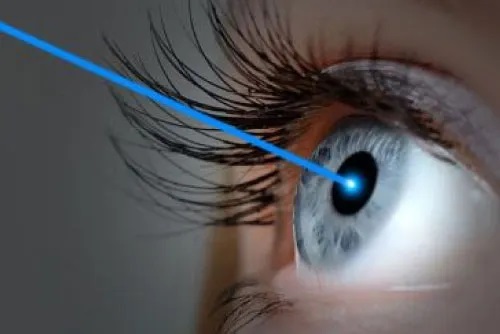
We are bringing custom All-Laser LASIK paired with the most modern technology and techniques to everyone.
Laser eye surgery is a term used to describe a collection of procedures. It commonly corrects short-sightedness (myopia), long-sightedness (hypermetropia) and astigmatism.
Different laser eye surgery techniques are used to correct each condition. These corrections are achieved through the use of a laser which reshapes the cornea (the transparent part) and adjusts the focus of the eye. Laser eye surgery at our centers is a brief procedure and is entirely painless due to the application of anaesthetic drops.
LASIK laser eye surgery is the most commonly performed treatment in india. LASIK is an acronym that stands for Laser-Assisted In Situ Keratomileusis.
Your eyes see by allowing light to enter through the cornea (the front part of the eye) and focus on the retina. The information is then communicated to the brain via the optic nerve.
Most people with poor eyesight have eyeballs that are either too long or too short in relation to the size of the cornea. Eyeballs which are relatively long mean that images focus in front of the retina, making you short-sighted. Eyeballs that are relatively short mean that images focus behind the retina, making you long-sighted.
Laser eye surgery reshapes your corneas with precision accuracy so that light will focus directly on your retinas. The result is that you will be able to see clearly without the need for glasses or contact lenses.

There are several different types of laser eye surgery techniques due to the varying conditions treated.
While most people are eligible for laser eye surgery, there are a few exceptions:
Under 18s – it is not advised that people under 18 have laser eye surgery as their eyes are still changing.
Pregnant women – Pregnancy can affect eyesight, so women are advised to wait until after they have given birth before presenting themselves for surgery.
Your prescription – Your prescription should be stable, ideally unchanged within the last two years, to ensure that the surgery will be effective. Laser eye surgery is most straightforward in a patient with a prescription in the normal range, usually between -10D and +7.25D.
Medical conditions – Some medical conditions can affect your suitability for laser eye surgery. Eye conditions like blepharitis leave you at a greater risk of infection, while general conditions like diabetes and epilepsy may render you unsuitable for this particular treatment if they are not under control. If the condition is well-managed however, you may be fine, so always seek advice.

A comprehensive, dilated examination is the only way to know which vision-correction procedure is best for you. We do this at no charge because we believe so strongly in giving patients all the information necessary to make the right treatment choice. While your exam involves comprehensive diagnostic testing, it is also our opportunity to learn more about you, your expectations, and your lifestyle. All of these factors play an important role in recommending the best procedure for you:
The complete exam can take up to 90 minutes. After all the data is collected, our doctor will examine you, discuss the treatment recommendation, and answer any questions you have. Your visit will include dilation of your pupils, which will affect your eyesight for about 4-6 hours, as you may have experienced with a routine eye exam.
We’d like you to leave your contacts out prior to your treatment. After carefully reading through the entirety of the literature you will recieve from your doctor, you will sign a copy of the informed consent in our office prior to the procedure. We will prescribe you an antibiotic drop and a steroid drop for use post-operatively. A SharpeVision team member will explain and give you written instructions for your post-procedure care, which includes using these eye drops four times a day for seven days following your procedure. Have a cool compress waiting for you in the refrigerator for when you get home. It will feel great on your eyelids after your procedure.
We understand that this procedure may create nervousness and fear. We’ve worked very hard to make it easy for you. We offer an oral sedative to help you relax, and we encourage you to take it if medically appropriate. We want your experience to be as comfortable as possible. All of your post-operative appointments will be scheduled before your procedure, so you can simply go home when the procedure is complete. Dr. Sharpe will gently talk you through each step of the process so you know what you will feel, see, and hear. He monitors your eye through the microscope at all times. The entire procedure takes about three minutes per eye; the first laser takes 20 seconds. The second laser takes 10-50 seconds depending on the amount of your prescription.
Immediately following the procedure, you will notice a change in your vision. It’s always foggy at first, but most people can see well enough to read a clock from across the room. Your eyes will be numb for 15-25 minutes; then they will start to water and burn. After LASIK, this discomfort usually lasts 4-5 hours. To help with the burning, we supply you with “comfort drops” that have numbing medicine and artificial tears in them. After being driven home, place a cool compress on your eyelids to relieve any discomfort. Try to sleep or rest with your eyes closed. You may resume normal activities the same or following day. You can lift and exercise, but do not rub your eyes. Your vision may still be foggy; this is a normal part of your healing process and will clear in the days and weeks following the procedure. Most people see well enough to work the next day.
Your eyes will start healing as soon as the procedure is over and you should see the results of your vision improvement immediately. You will be able to see things much more accurately but there may be a little blurriness shortly after surgery while your eyes stabilise so it’s important to arrange someone to meet you following surgery.
After 24- 48 hours the majority of patients are fully recovered and able to go about their usual day to day activities but this can vary depending on the type of laser eye surgery undergone.
If you happen to fall in that small percentage of patients for whom LASER is not the best option, there is still hope! You can get rid of your glasses and contacts with alternative laser vision correction techniques.
Micro-thin lenses placed inside the eye to correct a variety of vision problems.
Exchange your high prescription lens with a new 20/20 lens.
Laser-asssisted removal of a cloudy lens that’s replaced with a new lens. See like you did when you were young.
No, the laser can’t burn a hole in your eye. But it’s a good question. Find the answers to our most frequently asked questions at EyeVaidya. Some of them may surprise you!
One of the things that sets EyeVaidya apart is that we have every technology available to get you out of glasses, so we don’t have to shoehorn you into a procedure that might not be the best fit for you. The biggest two factors that affect the procedure recommendation and outcomes are: age and amount of prescription. Also important is your anatomy and eye health.
Your age is important, because our eyes go through different stages:
Your prescription amount (degree of nearsightedness) is important for several reasons. The higher the degree of nearsightedness, the more tissue LASIK and PRK removes from your cornea, and each person has a slightly different amount, and limit. we measure the thickness of your cornea with both sound and light to get a highly accurate measure. LASIK removes tissue from beneath the laser created flap. PRK removes tissue from the surface of your cornea.
Your ocular anatomy is important, in that some people are not LASIK candidates due to the shape and thickness of their cornea. If your cornea has signs of instability, or is too thin, we don’t operate on it. Some people can safely due PRK but not LASIK due to these same factors. Anatomy is also important when considering an Implantable Contact Lens (ICL) because you need adequate room between your natural lens and the back of your cornea to allow an ICL to be implanted.
Your eye health must be excellent to safely perform vision correction surgery. This is a big part of why we perform a free comprehensive exam with EyeVaidya.
At EyeVaidya, we offer LASIK, PRK, ICL, and IOL. The recommendation depends on your age, prescription amount, anatomy, and other factors. We spend a lot of time making sure you know the what, the why, and the pros and cons of our recommendation.
If your vision is worse after LASIK or PRK than it was before with glasses or contacts, it’s almost always due to dry eyes or residual prescription. Both of these are fixable with time (for dry eyes which is almost always the cause of foggy vision for a month or more after LASIK) or with additional laser to touch it up (which is necessary approximately 1% of the time and free for the first year after surgery).
Of course there are risks associated with every kind of surgery, and laser vision correction is no exception. To put it in perspective, however, the risk of laser vision correction is significantly less than the risks of wearing contact lenses. Yes, you read that correctly. The conclusion of a 2016 article from the academic journal Ophthalmology stated: “Compared with contact lens wear, current LASIK technology improved ease of night driving, did not significantly increase dry eye symptoms, and resulted in higher levels of satisfaction at 1, 2, and 3 years follow-up.” Price MO et al. Ophthalmology. 2016;123(8):1659-1666.
Most insurance/vision plans do not pay towards LASIK or PRK, but we do honor the discount from Eyevaidya. your out of pocket expense will be the same. Always check with your insurance carrier or health benefits administrator before coming in for your exam. A few forward-thinking companies are currently paying for some or all of their employees’ LASIK, PRK, and ICL.
Please note that you cannot wear contact lenses prior to your consultation or surgery. This is so we can take accurate measurements of your eye. You cannot wear soft lenses for 3 days before your consultation, and you can not wear gas permeable lenses for four weeks.
